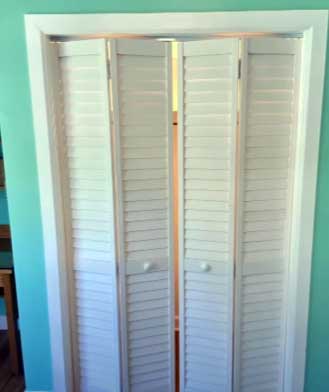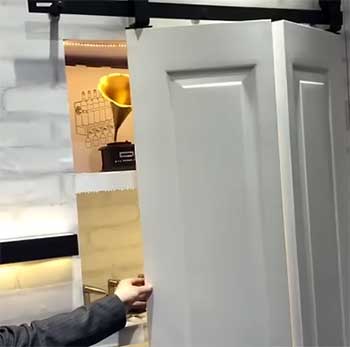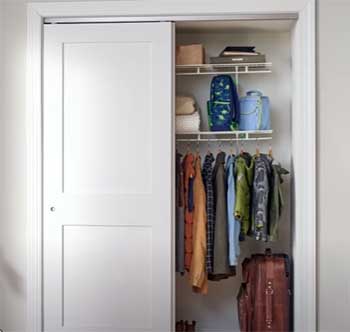I’ve spent countless hours rearranging my home, agonizing over every detail to make it both functional and stylish. When it came to choosing closet doors, I found myself stuck between sliding and bifold options.
Both have their charm, but which one truly fits your space and lifestyle? In this article, I’ll break down the pros and cons of sliding and bifold closet doors, share my insights from real-world use, and help you decide what’s best for your home.
Let’s explore the features, aesthetics, and practicalities to make your choice crystal clear.
A Brief Comparison Table
| Feature | Sliding Closet Doors | Bifold Closet Doors |
| Space Efficiency | Minimal floor space; slides along a track | Requires more floor space; folds outward |
| Accessibility | Partial access to closet at a time | Full access when fully opened |
| Installation Ease | Moderate; requires track alignment | Complex; needs precise track and hinge setup |
| Aesthetic Appeal | Sleek, modern, customizable | Traditional, versatile, cozy |
| Maintenance | Low; occasional track cleaning | Moderate; hinges and tracks need regular checks |
| Cost | $100–$1,000+ depending on materials | $50–$500+ depending on size and style |
| Durability | High; fewer moving parts | Moderate; hinges may wear over time |
| Customization Options | Mirrors, glass, wood, or metal finishes | Panels, louvers, or decorative inserts |
Why Closet Doors Matter?
Choosing the right closet door isn’t just about looks—it’s about how it fits into your daily life. I learned this the hard way when I moved into a small apartment and realized my closet door choice could make or break my space.
Sliding and bifold doors each bring unique benefits, but they also come with trade-offs. To make an informed decision, you need to weigh factors like space, accessibility, style, and maintenance.
I’ve lived with both types, so I’ll share what I’ve discovered through trial and error, along with practical tips to help you choose.
Key Differences Between Sliding And Bifold Closet Doors
When I was choosing between sliding and bifold closet doors, I realized their differences boil down to a few critical factors that shaped my decision. Here’s a breakdown of the key distinctions, based on my experience, to help you understand what sets them apart:

- Space Utilization: Sliding doors slide along a track, requiring no floor space for swinging, which was a lifesaver in my cramped apartment. Bifold doors, however, fold outward, needing clearance space—sometimes up to a foot or more—making them less ideal for tight rooms.
- Access to Contents: With sliding doors, only part of the closet is accessible at a time due to overlapping panels, which frustrated me during rushed mornings. Bifold doors open fully, exposing the entire closet, making it easier to grab items or reorganize.
- Mechanism and Durability: Sliding doors have a simpler mechanism with fewer moving parts, just tracks and rollers, which made them feel more durable over time. Bifold doors rely on hinges and tracks, which can wear out or sag, as I noticed after a couple of years of use.
- Aesthetic Fit: Sliding doors have a sleek, modern look, especially with mirrored or glass finishes, perfect for contemporary spaces. Bifold doors lean traditional, with panel or louvered designs that added a cozy vibe to my older home.
- Installation Complexity: Installing sliding doors was easier for me, requiring only track alignment. Bifold doors were trickier, needing precise hinge and track setup, which took extra time to get right.
- Cost Range: Sliding doors can range from $100 for basic models to over $1,000 for custom designs. Bifold doors are generally cheaper, starting at $50, with high-end options rarely exceeding $500.
These differences were crucial in my decision-making process, and understanding them helped me match the door to my space and needs.
Sliding Closet Doors: The Sleek Space-Saver
Sliding closet doors glide along a track, either at the top or bottom, making them a go-to for tight spaces. I first encountered them in a compact urban apartment where every inch counted. Their smooth operation and modern vibe instantly won me over, but they’re not perfect for every situation.
Pros of Sliding Closet Doors

One of the biggest perks of sliding doors is their space efficiency.
They don’t swing out, so you can place furniture right up against the closet without worrying about clearance.
In my tiny bedroom, this was a game-changer—I could fit a dresser just inches from the closet without issue.
They’re also incredibly versatile in design.
I opted for mirrored sliding doors, which made my room feel larger and doubled as a full-length mirror for getting ready. You can choose from glass, wood, metal, or even frosted panels to match your aesthetic. The customization options are nearly endless, letting you create a focal point or blend the doors seamlessly into your decor.
Maintenance is another strong suit. With fewer moving parts than bifold doors, sliding doors are less likely to break down. I only had to clean the tracks occasionally to keep them gliding smoothly. Durability is a plus too—my sliding doors held up through years of daily use without a hitch.
Installation is relatively straightforward, especially if you’re replacing an existing sliding door. The tracks need proper alignment, but it’s not rocket science. For budget-conscious folks, sliding doors can be affordable, with basic models starting around $100, though high-end options with custom finishes can climb into the thousands.
Cons of Sliding Closet Doors
Despite their appeal, sliding doors have drawbacks. The biggest one for me was limited accessibility. Since the doors slide over each other, you can only access part of the closet at a time. In my case, I had to shuffle clothes around to reach items behind the overlapped panel, which got annoying during rushed mornings.
Another issue is the track system. Dust and debris can accumulate, causing the doors to stick if you don’t clean them regularly. I once ignored the tracks for too long, and the doors started to drag, requiring a deep clean to restore smooth operation.
If not installed properly, sliding doors can come off their tracks. This happened to me once during a particularly enthusiastic closet reorganization. It wasn’t a disaster, but popping the door back into place was a hassle. Lastly, while sliding doors look sleek, they might not suit traditional or cozy home styles, where they can feel out of place.
Bifold Closet Doors: The Classic All-Access Option
Bifold doors fold in half as they open, running along a track and swinging outward slightly. I switched to bifold doors in a larger home where space wasn’t as tight, and their full-access design was a revelation after years of sliding door limitations.
Pros of Bifold Closet Doors

The standout feature of bifold doors is full closet access.
When you open them, the entire closet is exposed, making it easy to grab what you need.
I loved this when I was organizing my wardrobe or pulling out bulky storage bins—no more reaching around a half-open door.
Bifold doors also have a timeless appeal.
They come in a variety of styles, from simple panels to louvered designs that add texture and charm.
In my traditional-style home, the louvered bifold doors complemented the cozy vibe perfectly. You can paint or stain them to match your decor, making them a versatile choice for any room.
Cost is another advantage. Basic bifold doors can start as low as $50, making them budget-friendly for most homeowners. Even custom or high-end models rarely exceed $500, so they’re often cheaper than sliding doors for comparable quality.
Installation can be DIY-friendly for those comfortable with basic tools, though it’s trickier than sliding doors. I managed to install mine with a friend’s help, and the process felt rewarding, even if it took a few hours to get the hinges and tracks just right.
Cons of Bifold Closet Doors
The biggest downside of bifold doors is their space requirement. They need room to fold outward, which can be a problem in cramped areas. In my small guest room, the bifold doors bumped into the bed when fully opened, forcing me to rearrange the furniture.
Maintenance is another concern. The hinges and tracks can wear out over time, especially with frequent use. I noticed my bifold doors started to sag slightly after a couple of years, requiring occasional tightening of screws to keep them aligned. If you have kids who like to swing on doors, this could become a bigger issue.
The installation process, while manageable, is more complex than for sliding doors. The tracks and hinges need precise alignment, and any misstep can lead to doors that don’t close properly. I learned this the hard way when my first attempt left a gap between the doors, letting dust sneak into the closet.
Finally, bifold doors can feel dated in modern or minimalist spaces. Their folding design doesn’t have the same sleekness as sliding doors, which might clash with a contemporary aesthetic.
Key Features To Consider
When choosing between sliding and bifold doors, focus on the features that matter most to your space and lifestyle. Here’s what I prioritized:

- Space Requirements: If your room is tight, sliding doors are likely your best bet. They require no swing space, making them ideal for small bedrooms or apartments. Bifold doors need clearance, so measure your room carefully.
- Accessibility Needs: Do you need to access your entire closet at once? Bifold doors shine here, offering unobstructed access. If partial access is fine, sliding doors work well and save space.
- Aesthetic Preferences: Sliding doors lean modern, with options like mirrors or glass for a polished look. Bifold doors suit traditional or cozy homes, with panel or louvered designs adding warmth.
- Maintenance Tolerance: Sliding doors are low-maintenance, with only tracks to clean. Bifold doors require more upkeep due to hinges and tracks that can loosen over time.
- Budget Constraints: Bifold doors are generally cheaper, but sliding doors offer more high-end customization options if you’re willing to spend.
My Experience With Sliding And Bifold Closet Doors
Living with both types of doors gave me a clear sense of their strengths and weaknesses. In my small apartment, sliding doors were a lifesaver.
The mirrored panels made the room feel bigger, and I could tuck my bed close to the closet without worrying about door clearance. But the limited access drove me nuts when I needed to grab something from the far side of the closet.
When I moved to a larger home, I switched to bifold doors for the master bedroom. The full access was a dream for organizing, and the louvered design added a cozy touch. However, I had to rearrange the guest room to accommodate the bifold doors’ swing, which was a minor headache.
One thing I noticed was how much my lifestyle influenced my preference. If you’re someone who loves a minimalist, modern look and doesn’t mind partial closet access, sliding doors are fantastic. If you prioritize function over form and want to see your entire closet at a glance, bifold doors are hard to beat.
Practical Tips For Choosing
After living with both, here are my tips for making your decision:
- Measure Your Space: Before anything else, measure the area around your closet. Ensure you have enough clearance for bifold doors or enough wall space for sliding door tracks.
- Consider Your Routine: If you’re constantly in and out of your closet, bifold doors might save you time. For occasional use, sliding doors are less intrusive.
- Match Your Style: Think about your home’s overall aesthetic. Sliding doors elevate modern spaces, while bifold doors blend into traditional ones.
- Test Durability: Check the quality of tracks, hinges, and materials. Cheap bifold doors can sag, and low-quality sliding door tracks can jam.
- Plan for Maintenance: If you hate upkeep, go for sliding doors. If you’re okay with occasional tweaks, bifold doors are manageable.
Emerging Trends In Closet Doors
While bifold and sliding doors remain popular, I’ve noticed new trends shaking things up. Barn-style sliding doors are gaining traction for their rustic charm and space-saving design. They operate like standard sliding doors but add a bold, farmhouse-inspired look.
Pocket doors, which slide into the wall, are another option for those who want a completely hidden door when open, though they require more complex installation.
Open shelving is also trending, especially in boutique-style closets. Instead of doors, homeowners are showcasing their wardrobes with curated shelving units.
This works best if you’re organized and want your closet to double as decor, but it’s not ideal for messy folks like me who prefer to hide the chaos.
Frequently Asked Questions (FAQ)
It depends on your needs. Bifold doors offer full closet access and a traditional look, ideal for larger spaces. Sliding doors save space and suit modern aesthetics but limit access to one section at a time.
Sliding doors only allow partial closet access, can stick if tracks get dirty, may come off tracks if poorly installed, and might not fit traditional home styles.
Bifold doors require more floor space to open, need regular maintenance for hinges and tracks, can sag over time, and may feel dated in modern spaces.
Barn-style sliding doors and pocket doors are trending for their stylish, space-saving designs. Open shelving is also popular for showcasing organized closets.
Conclusion: Your Closet, Your Choice
Choosing between sliding and bifold closet doors comes down to your space, style, and daily needs. I’ve lived with both and learned that sliding doors are perfect for tight spaces and modern vibes, while bifold doors excel in accessibility and traditional charm.
Think about how you use your closet, measure your room, and consider your aesthetic preferences. You can’t go wrong as long as you prioritize what matters most to you. So, take a moment to envision your ideal closet setup—your perfect door is out there waiting to transform your space.
